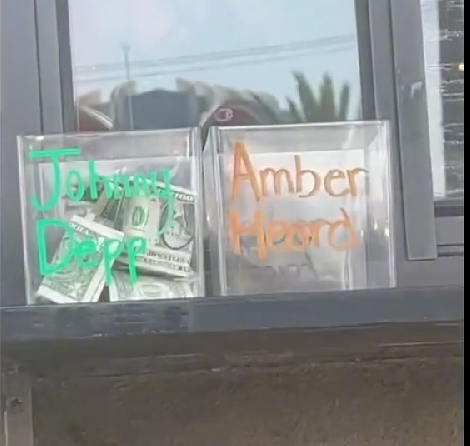
There is a difference between winning…and winning in the hearts and minds of the jurors.
In Fairfax County, Virginia, the scene of the highly publicized trial of John C. Depp versus Amber Lauarwa Heard, embroiled in multimillion dollar legal disputes, coffee drinkers all over the country are making their opinions known. The now-viral-video on TikTok trend showed two tip jars, one labeled “Johnny” and the other “Amber” in the drive-thru window.
And their contents reveal the sentiment of the “public jury” – Depp’s tip jar is overflowing with cash, smiley faces, and hearts. Heard’s, on the other hand, sits virtually empty with negative illustrations, frowns, and poop emojis. If these Starbucks voters were sent to the jury room to make their decision today, old Captain Jack Sparrow would emerge as the swashbuckling victor.
This :12 TikTok video perhaps says more about how the trial is going than hours and hours of testimony and transcripts:
The video speaks volumes about the court of public perception – how people feel about the idea of Johnny Depp or Amber Heard, Joe Biden or Donald Trump, Vladmir Putin or Volodomyr Zelensky, Pete Davidson or Kanye West. Now more than ever, these feelings run deep, coloring the way people think about celebrity, entertainment, and even important conflicts like the Ukraine Russian War.
These choices do not have to be rational or even accurate. They are emotions, after all. And we know most people speak from the heart rather than the head, especially on issues where they don’t have a stake in the outcome.
In the case of this blog post, the “jury” is a mixed group: consumers of all ages and backgrounds, ad agency execs, car dealers, politicians, local retailers, research analysts, and others who have the power and ability to vote with their feet. Or their ears. Or their wallets.
They’re the people on the ground who see what they see, hear what they hear, and form opinions as a result. And it’s broadcast radio “on trial” in the court of public opinion, up against competitors that include SiriusXM, Pandora, Spotify, and podcasts.
Unlike Depp v. Heard, these divergent groups all have a say in the success or failure of entertainment and information content – what it is and where it comes from. When they are together with their peers, and the subject rolls around to Netflix movies, music, comedians, or podcasts, most people have firm tastes and opinions they often hold near and dear. Most can be persuaded to try something new, especially if the conversation takes place among friends or confidants. But when a medium, a category, or a personality gets tainted and painted by a negative brush, making a comeback can be a heavy lift.
I once heard Pierre Bouvard say a truism that has stuck with me over the years:
“Perceptions are like glaciers….slow to form and slower to melt.”
We saw this vividly with a question in Techsurvey 2020 (fielded just weeks before the pandemic hit American shores). We asked respondents to estimate – OK, guess – the percentage of Americans 18+ that listen to broadcast radio, Pandora, Spotify, and SiriusXM in a typical week. Now keep in mind, our sample is made up primarily of core radio listeners – mostly members of station email databases. If opinions are going to lean in any direction, broadcast radio has a decided edge in Techsurvey.
When we got the data back, we winced. OK, cringed. As we had theorized, respondents overestimated the popularity of satellite and digital streaming platforms. And they greatly underestimated the percentage of those reached by AM/FM during a routine 7 day period. Don’t tell me marketing doesn’t work.
We put the actual reach percentages together with the help of several sources: Nielsen, Edison, and quarterly reporting to Wall Street. The numbers speak volumes about the perception of who reaches the most adults in America every week:
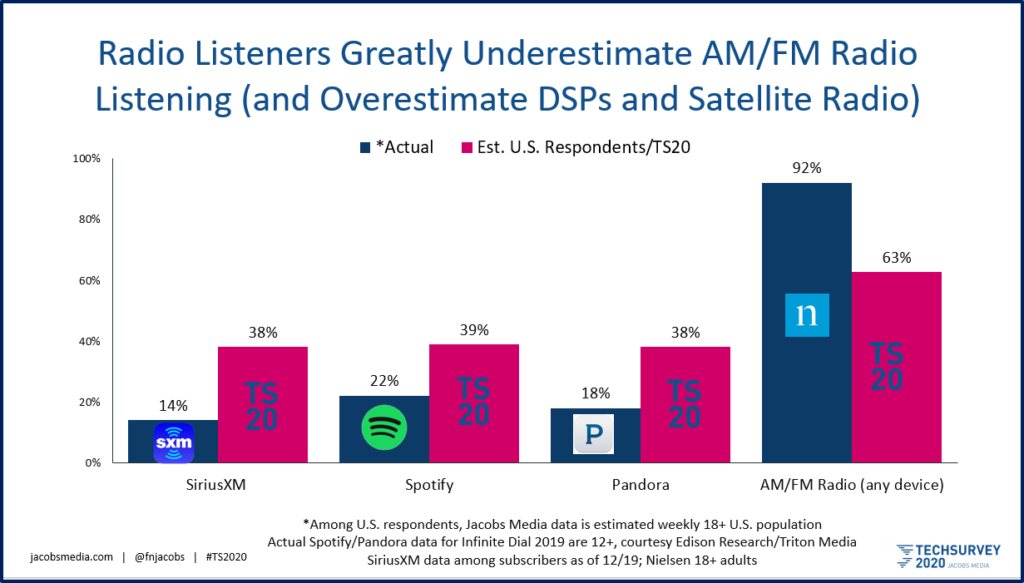
The actual reach levels are in dark blue, while Techsurvey 2020 respondent perceptions are in raspberry. Our radio-friendly group overshot Spotify, Pandora, and SXM’s popularity – the latter two by more than 2x their actual reach levels.
For broadcast radio, that 92% figure we hear with numbing regularity from radio leadership and Nielsen analysts doesn’t square with even the medium’s most loyal listeners. In fact, they guesstimate fewer than two in three adults tune in any AM/FM radio on a given week. While that still leaves broadcast radio with a substantial lead, it comes nowhere close to the medium’s actual reach versus its digital and satellite delivered competitors.
The fact is, radio is stuck with solidifying perceptions the medium is in serious decline. That many former listeners have moved on. That radio sounds the same everywhere you go. That stations play seemingly endless numbers of commercials – back-to-back – all in a row. That evil corporations pick the music from afar. That no one actually wins radio contests because they’re fixed.
Fast-forward to the present, and we learned in Techsurvey 2022 that three in ten core radio listeners now drive truly “connected cars,” and that eight in ten are now able to pair their phones in their cars, SUVs, and trucks. Yes,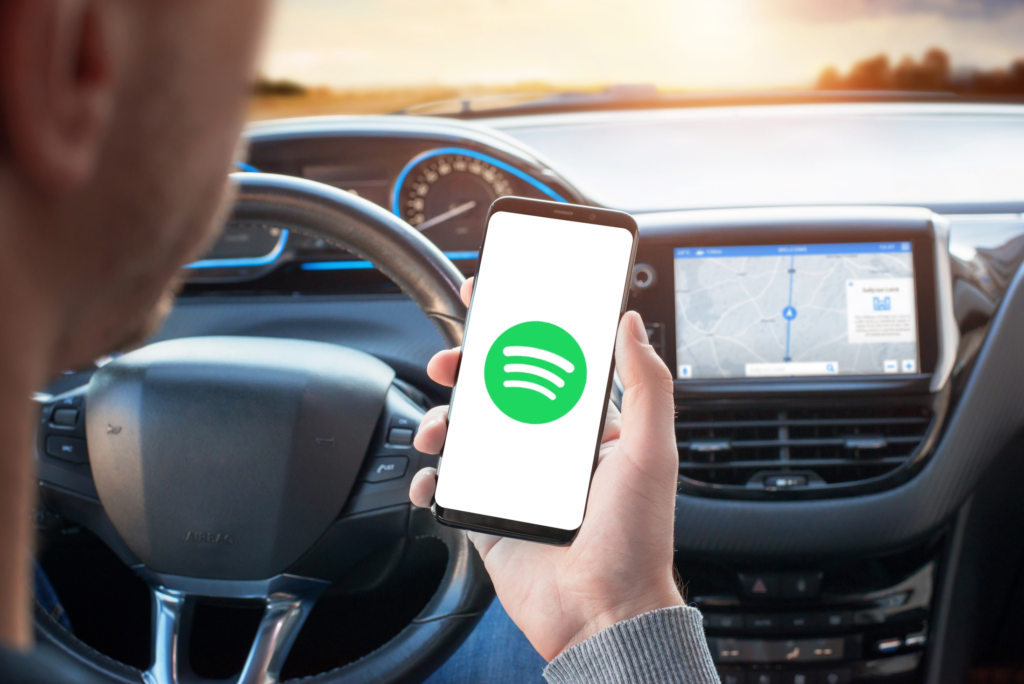 people are still listening to AM/FM stations while driving – just about everyone’s research indicates radio is still the top choice while consumers are on four wheels. But the equation is shifting. Radio no longer dominates the driving experience. And as automakers offer easy access to satellite radio and reams of content on smartphones, we know where the puck isn’t just headed, but where it is right now. The “old order” is undergoing a serious shift, thanks in no small part to disruption in cars.
people are still listening to AM/FM stations while driving – just about everyone’s research indicates radio is still the top choice while consumers are on four wheels. But the equation is shifting. Radio no longer dominates the driving experience. And as automakers offer easy access to satellite radio and reams of content on smartphones, we know where the puck isn’t just headed, but where it is right now. The “old order” is undergoing a serious shift, thanks in no small part to disruption in cars.
Where there’s smoke, there’s usually fire. And the above perceptions didn’t materialize out of thin air or even since the pandemic. True, some opinions been aided, abetted, and even accelerated by radio’s growing list of competitors – from satellite radio to DSPs to podcasts – all of which have attempted with some success to associate broadcast radio with old technology, like the dial phone, VCR, and Walkman. COVID didn’t cause this, but it sped up trends that were already forming.
Truth be told, broadcast radio has brought much of these negative perceptions on itself. Bloated commercial loads grew in the 90’s, exacerbated by the rigid policy of airing two ridiculously long stopsets per hour in the nation’s biggest markets. To make matters worse, the majority of stations in PPM metros program their commercial breaks at virtually the same times, making the listening experience even more annoying.
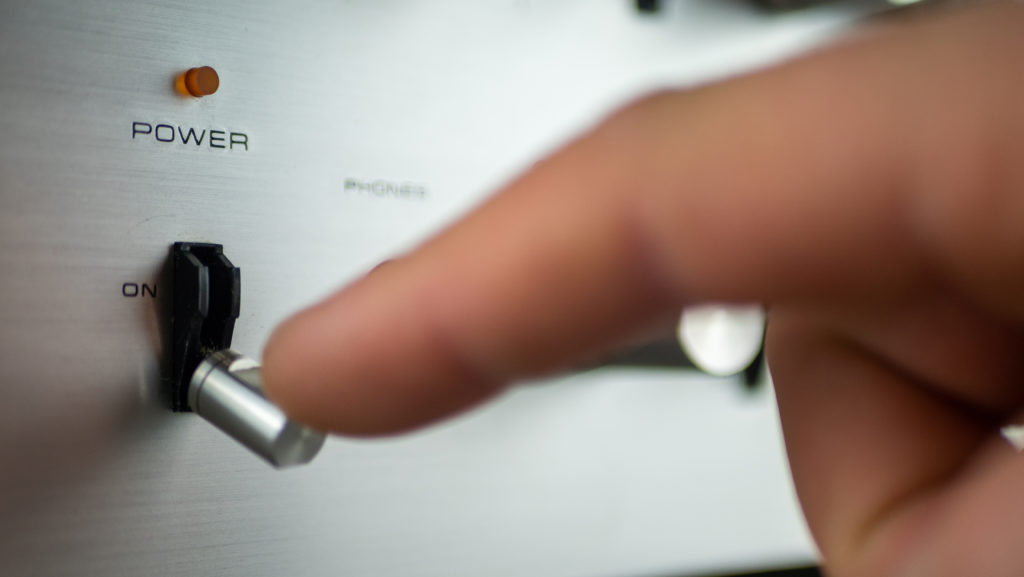 All of this is being done in order to curry favor (or eliminate tuneout) among a thousand or so panelists carrying around meters. The hope is these programming policies keep panelists tuned in. Yet, it can be argued the collateral damage from these tactics now outweigh whatever value they once had in the early years of PPM.
All of this is being done in order to curry favor (or eliminate tuneout) among a thousand or so panelists carrying around meters. The hope is these programming policies keep panelists tuned in. Yet, it can be argued the collateral damage from these tactics now outweigh whatever value they once had in the early years of PPM.
Most broadcasters care more about that one 39 year-old Hispanic female in Redondo Beach or that lone 27 year-old “other” male in Crystal Lake carrying a meter than they do the tens of millions of actual consumers who are still listening. Radio stations in the top 48 markets often spend what few “marketing” dollars they have left chasing meter holders rather than building their brands, their staffs, and their audience and advertiser engagement.
Radio broadcasters are now heavily invested in the hope that Congress will pass another round of deregulation, praying new leadership at the NAB get help get it done. That would allow them to essentially “own” markets, rather than share what’s left of the “radio dollars” with another owner (or two) in the metro.
But in the last quarter-century since the Internet took flight, few have done little to distinguish themselves over the publicly owned airwaves. even with the Telecommunications Act of 1996, the legislation that sanctioned in the current leniency of ownership rules. Format innovation, the emergence of great personalities, and well-produced audio content have taken a backseat to budget cutting, rampant and expedient voicetracking, and a reduction of local community service and presence in cities of license.
In these modern times, the debut of a “new” format isn’t exciting or novel at all. In fact, we’ve heard them all before because they are almost always selected from what I have called the “Wheel of Formats” – the same-old array of safe but bland choices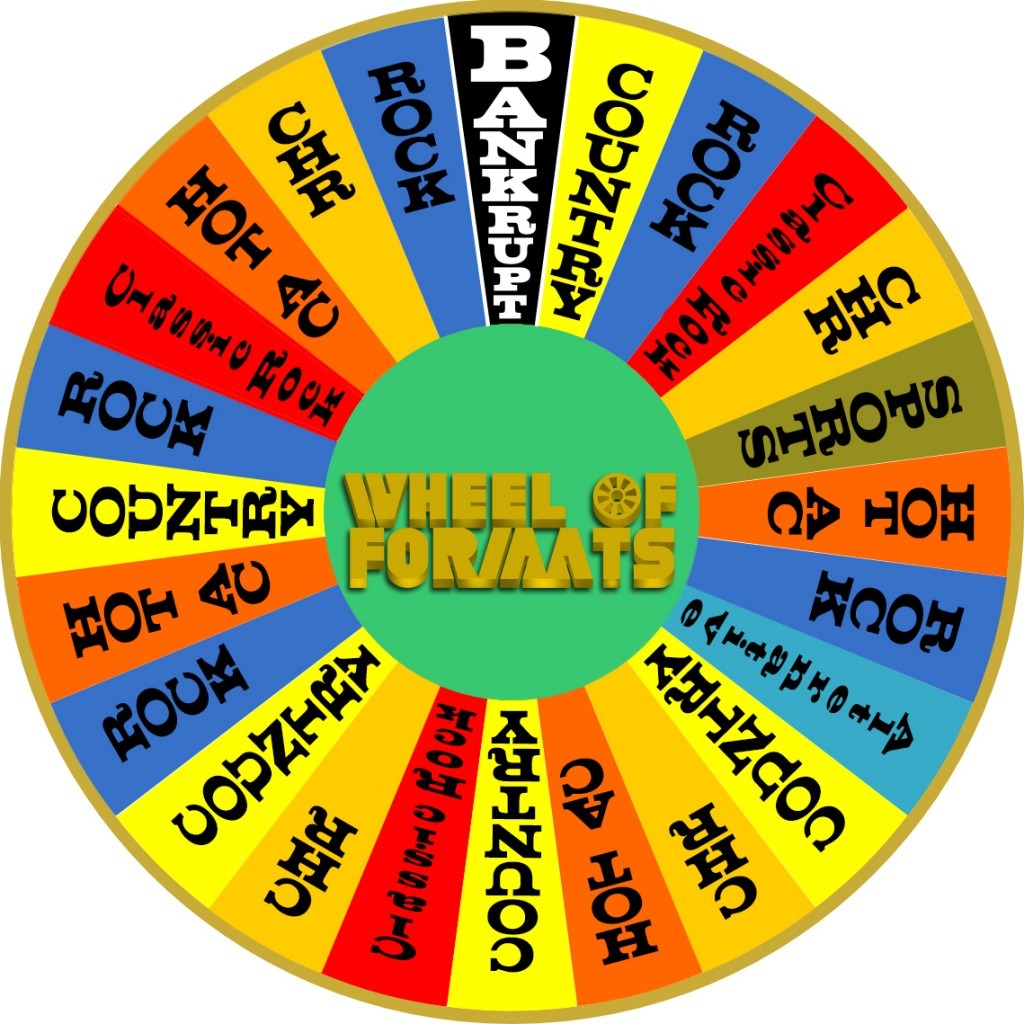 that produce absolutely no buzz or energy. These flaccid radio debuts are typically heralded in by a tired countdown clock, construction sound effects, and the unveiling of a “new format” (that isn’t the least bit “new”) with x number of songs commercial-free. Even the most naive of consumers know what’s coming in a just a few short weeks.
that produce absolutely no buzz or energy. These flaccid radio debuts are typically heralded in by a tired countdown clock, construction sound effects, and the unveiling of a “new format” (that isn’t the least bit “new”) with x number of songs commercial-free. Even the most naive of consumers know what’s coming in a just a few short weeks.
When was the last time someone uttered the phrase, “Have you heard that new radio station that just signed on?” Sorry, but for most listeners in most markets, it’s been decades.
What has been uttered, especially in the 90s by ownership smitten with hubris, is this phrase: “Where else are they going to go?” It was directed not just at listeners, but at advertisers.
Pre-Internet, that was an arrogant statement, but a fundamentally correct one. Today, it is a question only a fool would ask. Where else are they going to go? We can’t count the bona fide places on two hands anymore. Consumers have not only found alternatives to broadcast radio, they have flocked to them on gadgets like smartphones, tablets, and Alexa, disrupting a century-old industry that could use more friends and fans.
Sadly, radio broadcasters have mostly squandered streaming, HD2’s and 3’s, new music discovery, and personality development, all in the hope of saving money, cutting our way to profitability, and earning higher Nielsen ratings. As to that latter goal, we can no longer truly monetize those reach and frequency numbers anyway because spot demand and average ratings are so low. And that’s led to a deluge of remnant advertising and even bonusing those extra FMs that once had promise to be paragons of programming innovation. Now, we just throw them into cluster buys because that’s what they’re worth. Like those “But wait there’s more…” ads for Popeil products and Ginsu knives that used to populate late night TV. When people actually watched real-time television.
And the ratings, the Infinite Dial, and our Techsurveys all point to the same results – usage declines, whether it is reach, time spent listening, lower PUMM levels, and most other metrics. Just looking at shares is deceiving. The evidence is clear, consumers are gravitating away from the medium, while some never get there in the first place.
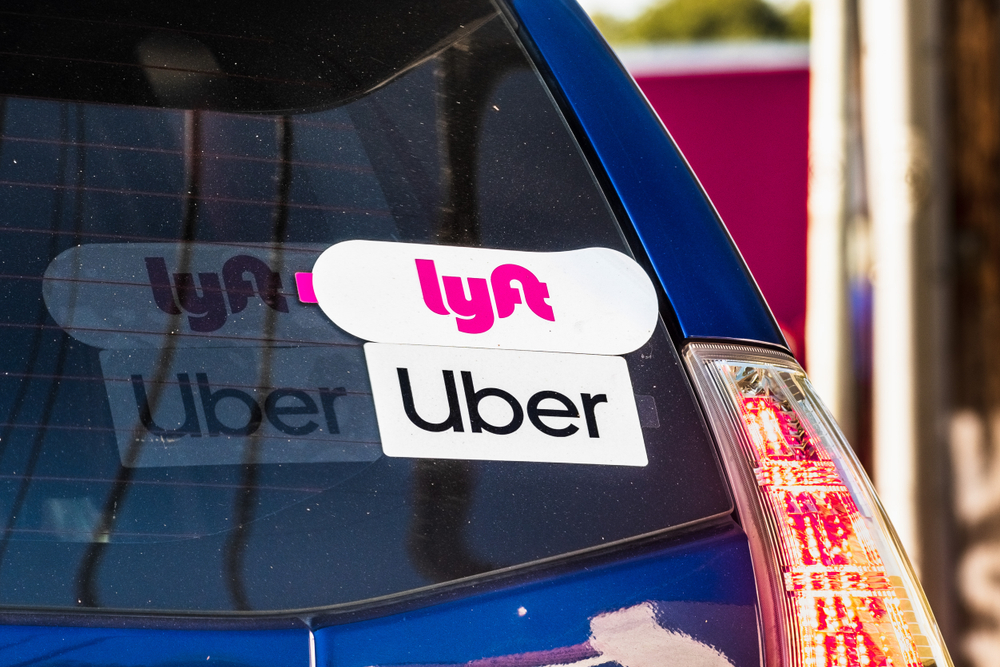 How many stories like the one below have you heard in the past couple of years…or past couple of days?
How many stories like the one below have you heard in the past couple of years…or past couple of days?
Paul and I are meeting with an international broadcaster in Vegas last week who is trying to get his arms around American radio. He jumps in an Uber on his way to the Convention Center, hears music playing, and chats up the driver about what she’s listening to. It turns out it’s Spotify, and he asks her what radio stations in town she enjoys.
And she replies, “You know, since I’ve owned this car, I don’t think I’ve ever turned the radio on.”
Ouch.
He asks us his version of “WTF” and we have no response but to shake our heads, and say, “We know.”
Could that be true? It could and it probably is. We see it in Techsurvey each year. And we hear it anecdotally all the time.
What will another round of deregulation → consolidation mean to radio ownership?
It depends.
It could delay the inevitable, keeping profits rolling in for another few years while the radio product and advertising experience further atrophies.
OR…
….it could present a pathway toward creating a better radio listening and marketing environment.
Now I know what you’re thinking: someone’s put something in Fred’s Starbucks. And if past is prologue, none of us should be heavily placing our chips on the bet anything is likely to change.
But sometimes all it takes is one or two visionary players to actually try something new. And as we know, radio broadcasters tend to mimic strategies and tactics that are working.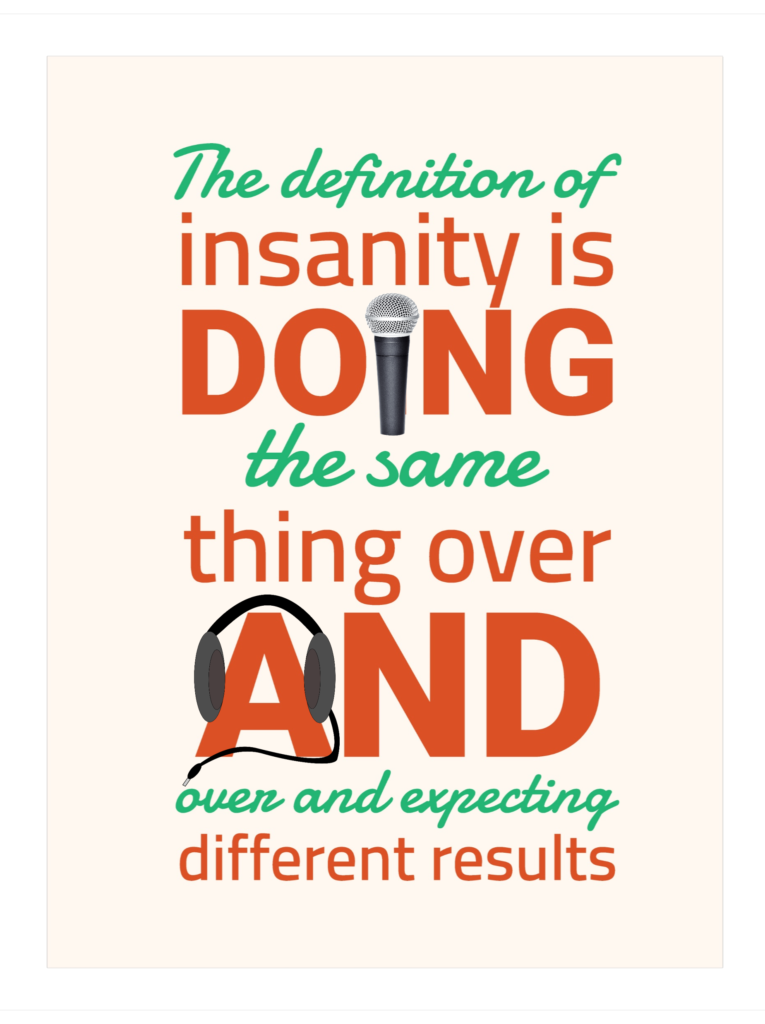
In tomorrow’s post, I’ll get specific and offer up a list of maneuvers that could possibly change the trajectory radio is on.
That’s because staying the course will simply lead to more erosion and continued lower usage and engagement with the medium.
Like the definition of insanity, radio could use a new playbook.
Or even a couple of trick plays that might help change perceptions of radio.
So, in which jar will you put your tip?
Part 2 of this blog post is accessible here.
For the latest results of Techsurvey 2022 – and what it means to radio broadcasters – join Fred Jacobs on Tuesday, May 10th at 2pm ET for a free webinar. Details and registration here.
- Media And Technology In 2025: Believe It Or Not! - April 18, 2025
- In Radio, You Just Never Know - April 17, 2025
- The Secret To Making A Great Podcast (And Great Radio) - April 16, 2025



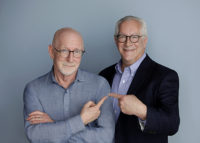
More in this blog than I can reply to at once so I’ll center on just one item: The 92% Figure.
It’s not that the figure is right or wrong it’s that it is irrelevant.
The perception of AM/FM listening varies so greatly from The 92% Figure because the perception is not based on casual, infrequent (one a week for a couple of minutes) accidental tune-in but on intentional, engaged listening.
The continued use of The 92% Figure is a marketing ploy that is doing more harm to the medium’s efforts to rebuild revenue.
As long as The 92% Figure remains the focus of the medium, the cpm’s, cpp’s will continue to decline. There are many ways to promote the medium’s value to advertisers. The 92% Figure is not one of them.
I’m totally on-board with that, Barry. I think that some broadcasters were looking for a big number with which to wow Wall Street. That probably worked for a while. As a research guru explained to me when I was just coming up, radio has a tendency to focus on small numbers – we have a .4 rating. Or we have a 4-share. Perhaps this weird reliance on 92% is an outgrowth of that. Thanks for the comment.
There’s also the fact that no advertiser buy ever reached 92%. A schedule of commercials more typically will achieve a market/demo net reach of 40-60%. The 92% is in reality unachievable and so it does make salespeople look dumb when they quote The 92% Figure.
Barry’s comment is “spot” (pun intended) on. The truth is, even in its best days, almost no one bought radio because of its reach. And I wonder, in the diary markets where ratings are at least theoretically intentional and most talk breaks are tracked, whether, particularly in among 18-34s, those once a month (which is what’s often cited now) numbers are at the 92% level.
Further hurting its case are those “tops in ad supported audio” pieces. Ad supported audio is being hurt, perhaps fatally by subscription services and being number one there is what John Hughes referred to as being “king of the dipsh*ts”.
I always laugh disparagingly at people who say stuff like this, but I’m going to do it anyway. Who are these people who Nielsen says listen to all this radio? I don’t know any of them. The only radio that anyone under 40 I know listens to is on short car trips. That’s it.
I’m on the board of a non profit that includes a student staffed alternative formatted commercial FM (yep, no kidding) and no students are interested in doing shifts – not few, NONE. They flock to and create great spoken word programming (sports, podcasts, news) imagined and created their own record label and have an online block programmed station – the energy is infectious, just not for FM radio and as recently as ten years ago every FM shift was filled with students.
Radio isn’t going to reinvent itself if they get to own every station in a market and if anyone thinks so, I’ve got a flimsy bandana I’d like to sell you that will protect you from getting Covid.
Bob, see my comment to Barry regarding 92%. As for those kids averse to radio, that (mostly) checks with what I hear. However in our work with the College Radio Foundation, I’ve run into college stations that work, like the Globe in Goshen, IN. There are others, too, but I suspect the faculty advisor has a lot of sway. As an industry, we have pushed young people away for decades. It is no surprise they’ve moved on.
Bob – the reason you’re seeing no student interest in the radio station is precisely because of what is is: “alternative formatted commercial FM“. I’d bet there’s little to no overlap between the playlists of the online only station where your students play whatever they want – vs the commercial alternative format. The college station whose board I sit on has never seen more student interest than this past semester, and I’m hearing that’s the case at other college stations, specifically because the students choose all the music they play. That’s what triggers their interest. None of these students will pursue careers in radio when they graduate. While a free form / anything goes college station won’t be commercially viable, seeing adventurous non-comms like KEXP and KCMP scoring ratings in other markets merits study. It’s the only kind of music radio most of my college educated friends now ever consider listening to when they’re not listening to NPR.
Regarding Uber, it looks like the company is launching a weekly informational show on stations in Mexico City that’s aimed at its drivers. Even though I’d still take it with several grains of metaphorical salt (regarding both the show itself and the fact that it’ll be on a pair of AM stations, albeit venerable ones), this does show that Uber can (and wants to) partner with broadcasters in some markets.
https://aristeguinoticias.com/2804/dinero-y-economia/uber-lanza-programa-de-radio
I know some radio PDs who would love to program Uber Radio. Thanks, Eric.
Fred
Great read again brother. We are talking the same language. I have the vision, but the people with the resources are not listening. After 35 years in this business, I’ve learned a few things and so I created a brand new radio format in line with what you’re talking about. “Rhythmic Gospel” targets the 18-34 African American female with Christina Hip-Hop and R&P (rhythm & praise). I am casting the nets, but these sharks are a stubborn bunch. Listen here https://rdo.to/IKJZ
It’s tough out there. Hang onto your ideas. You never know when things shift. I can tell you it took me the better part of three years to give Classic Rock a try on an FM signal. And we know how that one worked out. Thanks for connecting.
Listening right now, VonRoy! This is amazing! Pre-pandemic I was regularly attending a Saturday night church service with music similar to this–and it was a PACKED with young people–teens, twenties and thirties. (And it was a large church!) R&P! LOVE it! Keep up the great work! There’s a lot of youth out there who just need to find you! Who knows? You just might be the next Classic Rock!
Concise and damning without being mean. Nicely done Fred (again!. Judging by their actions, the large corporate broadcasters have a ‘melting ice-cube’ investment theory. Invest as little as possible, make as much money as possible while the ‘ice cube’ melts and count on enough return over the next 10 years to walk away and shut it down at some point in the future. I hate to say it, but it’s NOT a bad investment strategy. It’s just a lousy ‘radio’ strategy.
Looking forward to you ideas…cheers!
Reading this–“not a bad investment strategy (but) lousy ‘radio'”–and can’t help but wonder, would I do anything differently?
Jackson, I appreciate the kind comments. To say I’m hesitant about tomorrow’s post is an understatement, but I am hopeful an idea or two will resonate with people like you. Your “investment strategy” may indeed be the unspoken plan some owners believe could come true. But I’d like to believe there are others who are deeply committed to the industry’s survival for all the right reasons. Thanks for weighing in on this one.
“But in the last quarter-century since the Internet took flight, few have done little to distinguish themselves over the publicly owned airwaves. even with the Telecommunications Act of 1996, the legislation that sanctioned in the current leniency of ownership rules. ”
Every time I hear John Prine’s “Paradise”, I think of how the big companies came in and strip mined the radio industry.
“Then the coal company came with the world’s largest shovel
And they tortured the timber and stripped all the land
Well, they dug for their coal ’til the land was forsaken
Then they wrote it all down as the progress of man
And daddy, won’t you take me back to Muhlenberg County?
Down by the Green River where Paradise lay
Well, I’m sorry, my son, but you’re too late in askin’
Mister Peabody’s coal train has hauled it away”
A certain fast-food company has been saturating media for years to enhance its perception. Their share is between 20 and 29 percent. I’m sure their perception is much lower despite reality. It’s becoming more and more evident that radio (AM/FM) has an increasing issue that’s not being addressed by other than smart people like Fred and the rest of the posters here. Todd Storz at KOWH used a “focus group” in a bar to develop what we know as “Top 40”. It was easy back then, and it should be easy in 2022. The people at the bar Storz frequented said they played the same songs over ‘n over because “they liked them”. Can we find out what radio listeners LIKE-and give it to them ? Combine that with the brilliant minds that can present that in a highly entertaining package and then PROMOTE IT!! How difficult can that be ? I guess for the “ice cube” watchers-very. It’s a much more diversified world today than it was 25 years ago, and there’s a massive amount of media choices. Is AM/FM winning? Other than the fun folks who congregate here daily, does anyone care?
The broadcast environment decades ago, when formats like Top 40 gestated, was like my back garden in the early spring: The plants of choice (eg, radio stations) take root and thrive. That environment has changed and become more challenging. It’s now like my garden when I’ve been absent for a few weeks: The plants I want must compete with a lot of plants I didn’t want (eg, streamers, satcasters) and my work is cut out for me if I want my preferred plants to dominate.
I don’t like to call SXM et al. “weeds,” but I think that is how radio managers need to see them. And recognize that their neglect of our garden was not benign.
I’m just wondering where dandelions fit in, John. 🙂 You are so right about SXM & others. They are impediments to growth, but reminders we need to be great cultivators and stewards of our “gardens.”
The most innovative format experiment that seems intent on trying to create something that young listeners and some of us oldsters will seek out and become loyal to is part of WRAL’s group in North Carolina. “That Station” in Raleigh. https://thatstation.net/
I think it’s an HD2 experiment that is available too via an easy-to-manage App and maybe an AM and FM there locally but I’m not in that town to be sure. I listen regularly from New Mexico! I’d call its format a hybrid of AAA/Classic Rock/Local Music that features newer semi-Americana music that feels compatible with what Boomers grew up loving, and a healthy called-out dose of North Carolina bands. About every 4th song seems on or near any slightly wide Classic Rock playlist to keep me around in case I get antsy with the novelty of artists I don’t know that well – yet. But usually I happily stick with it.
Definitely has young sounding hipster DJ’s. Old school, simply-produced, music-less ads featuring heart-felt invitations (“come-on-down”) from the business owners only. No long ad-sets — yet.
I’m intrigued and wondering how they are doing so far. You know about this one Fred?
Paul
Listening right now, Paul. “That” really is some station! Very likeable. Not familiar with the music I’ve heard so far but really like the overall sound and vibe. I almost can’t believe my ears that something that fresh and innovative is actually playing on a station (or three) somewhere. Good for them. Let’s hope one of these more adventurous formats gets some traction–and the equally adventurous broadcasters behind them show everyone else it CAN be done! (Update: Just heard a break and the girl was smooth and comfortable and didn’t sound like a robot reading state liners that couldn’t mean less to me.) Yes, I could very much see telling others about “That” station.
So much to get one’s arms around in this brilliant post. Let me start here: I love radio. I was born into what one might consider “radio’s heyday.” Radio provided me and my family an amazing career, and I was able to make a good living doing something I loved. Radio, done “right,” is FUN.
When I turn on any number of “local” radio stations today, I hear little to no “local” content, not to mention so many commercials during a break that I literally lose count. The industry has too many self-inflicted wounds, and while I believe that it can reinvent itself, as it has many times before, I fear that there are many leaders who don’t have the will or desire to do what it takes to make that happen. But hope springs eternal.
Bruce, as you know, I’m a dreamer, too. It’s not a matter of going back to the “good old days” (many of which weren’t so good) but remembering the fundamentals that made great stations great. I was proud when WRIF was named station of the year here in Detroit by the Free Press. For a station more than a half century old, it’s impressive. Others are making it happen in their markets, too. We just need more.
“And it’s broadcast radio ‘on trial’ in the court of public opinion, up against competitors that include SiriusXM, Pandora, Spotify, and podcasts.”
And this is exactly where radio went wrong.
Radio viewed these entities as competitors that radio must emulate and duplicate.
Radio gave up what made it famous, to chase these entities. That’s why they are viewed as direct competition to radio in the first place.
That’s because radio wants so desperately BE THEM, and not true to its own inherent strengths.
Fred,
Such a good read. So much to unpack. I’m going to focus on just 3 things.
Competition is good. Spotify, Sirius, they should be inspiration to up our game. Instead, it seems like every time they get a leg up on us, we chop the one we’re standing on, off! How has this become more of a hurt than a help?
PPM, as a small market PD who doesn’t HAVE PPM in their market, but I have to use M scores for music, we need a better music model and a better way of gauging listenership. The PPM was great, until it was abused and used for things it shouldn’t be used for… like song burn. It is GREAT for actual EXPOSURE to a station, but simply should not be used to gauge an announcer or song based on HOW it’s used. There is a lot of “forced listening” in the PPM world, like what’s playing in the doctors office or garage when you visit. You leave when you’re done with your business, not because Led Zeppelin is on in the store. Radio has abused the PPM and now it’s coming back to get us.
The second, is that every good thing that can happen in radio is top down. Top down from the board of directors, to the gms, to the oms then finally to the pds and jocks. We can’t just execute a great plan anymore.
I hope the bigs who you talk to can really hear you when you say these things. They’re the only ones who can make the changes needed.
Tammie, I always appreciate your comments and your honesty. You just put it out there, and it’s always from the heart.
For as long as I’ve been doing this, radio broadcasters have abused the ratings. So, PPM is just the standard currency for big markets, no more, no less. That Nielsen makes it easier to abuse them is what makes me crazy.
And you’re right about the top-downness. I believe there are some good broadcasters in the industry today, trying to do the right things, in a much different and more difficult environment than ever before. I know many believe corporate radio caused all these problems. And while some were co-conspirators, the technology of the past couple decades have been unstoppable.
I appreciate the kind words, and I will continue to push. We simply have to be better.
Hey Fred,
I’ve been very much “enjoying” your recent doses of radio reality. Although my beat nowadays is small market radio, even that segment is not immune from the tendencies that are causing our medium’s downfall. (I don’t think I had a chance to compliment you on your profile – or maybe it was Paul’s – of the Potters and their small market operation. I hereby dub you guys honorary small market broadcasters.)
Last week, on the occasion of WRIF winning the Detroit Free Press reader poll, I commented that there was a radio station that stayed the course, formatically and promotionally, despite the inevitable ups and downs of ratings, for 50 years, resisting the temptation to blow itself up and find something “new” from your Wheel of Formats. (Having launched a couple of stations that have stayed the course as well, I’d like to think that both of us are so damn good that our playbooks have stayed on the desks of our successors and are consulted regularly. Probably not.)
Jay, thanks for this. I am proud of WRIF, but I also know full well that I am just one of many who worked to build a legacy that has endured for half a century. Some really great people came before and after me. I’d like to think some of the foundational stuff I did stuck. I’m just glad the brand is around, stronger than ever, and serving a great community.